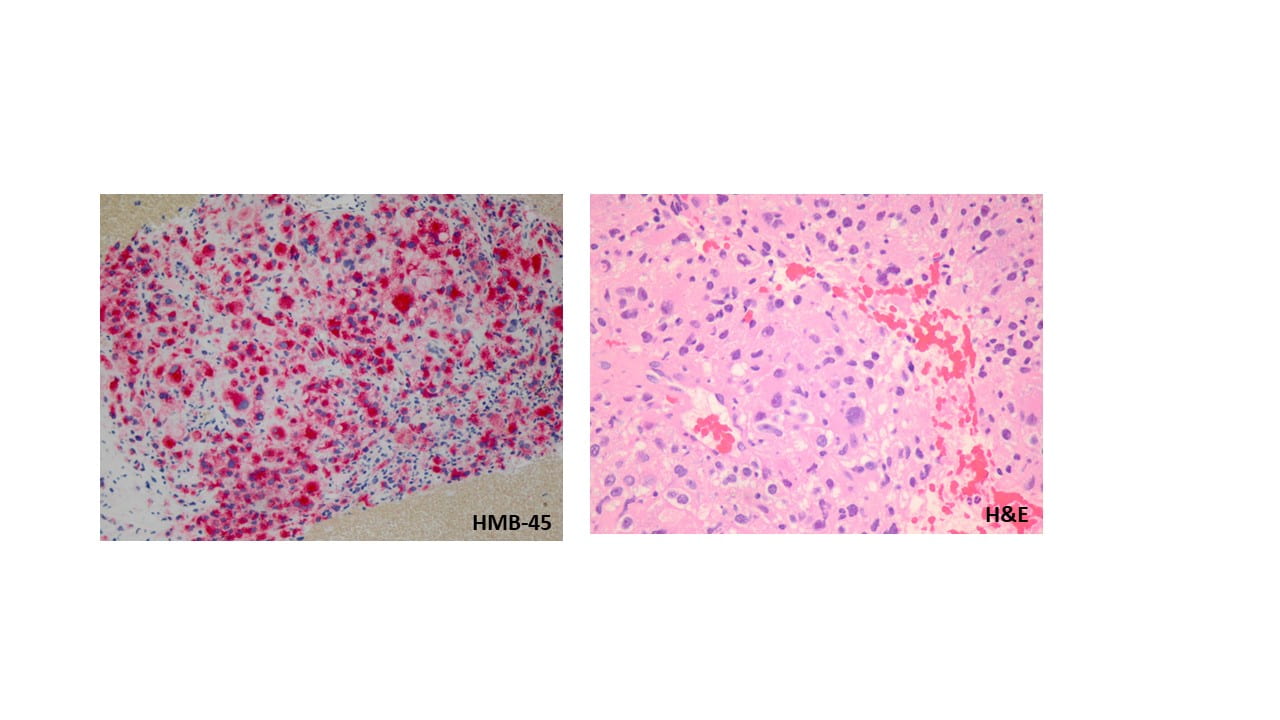Clinical information:
55-year-old male with history of asthma and reported history of previous lung granuloma presented to an outside hospital with persistent cough for 9 months and was found to have a 10 x 10 x 10 cm left lower lobe mass on imaging. PET CT showed the large lung mass with hypermetabolic activity, but without evidence of hypermetabolic activity elsewhere. CT guided biopsies were performed at an outside hospital which were reported to have poorly differentiated malignant cells and necrosis, but were inconclusive for a specific pathologic diagnosis. The case was sent to Mayo Clinic for consultation and was reported to most likely represent a poorly differentiated non-small cell carcinoma. This previous biopsy material is not available to us for review. An EBUS with FNA biopsy was performed at Keck Hospital.
Microscopic findings, cytologic features, and immunohistochemical profile:
Moderately cellular smears show small clusters of and singly dispersed large atypical cells with marked anisonucleosis and poikilocytosis, round to oval nuclei, clumped coarse chromatin, multiple prominent nucleoli, and abundant foamy to granular cytoplasm. Numerous multinucleated giant cells are seen. The background consists of blood and blood elements. The cell block shows similar findings with the atypical cells growing around thin-walled capillary vessels and foci showing intranuclear pseudoinclusions. Mitoses and necrosis is not identified.
The tumor cells are positive for HMB45, patchy positive for Melan-A, SMA and TFE3 while negative for S100, SOX10, and AE1/AE3. The KI-67 proliferative index was about 5%.
Of note, the concurrent lymph nodes sampled were all negative for malignant cells.
Discussion:
Perivascular Epithelioid Cell tumors (PEComa) are a distinctive class of mesenchymal neoplasms arising from perivascular epithelioid cells demonstrating combined myomelanocytic markers. They are rare and have a marked female predominance. PEComas of the lung are usually benign and include defined subtypes such as angiomyolipoma (AML), clear cell sugar tumor, and lymphangioleiomyomatosis (LAM). These tumors frequently show association with tuberous sclerosis complex (TSC) and have frequent deletions of the TSC2 gene. Most others are sporadic and a small subset are associated with TFE3 gene fusions.
Our case showed overexpression of TFE3 immunohistochemical stain, which is seen in tumors associated with TFE3 gene fusions. This may have therapeutic implications for aggressive tumor in the future.
Malignant lung PEComas are exceedingly rare, with about 8 reported cases in the literature. Primary diagnostic criteria for malignant PEComa include: prominent coagulative necrosis, mitotic figures ≥ 1/50HP, invasion of adjacent pleura or viscera, and evidence of distant metastasis of homology. Secondary diagnostic criteria include: tumor size ≥ 3 cm, spotty necrosis, high mitotic index ≥ 5%, multinucleated tumor giant cell ≥ 5/50HP, marked hypercellularity, nuclear atypia and pleomorphism, and numerous intranuclear pseudoinclusions. Criteria for diagnosis of malignant lung PEComa is such that if the tumor meets 1-2 major diagnostic criteria and/or ≥1 secondary diagnostic criteria. If the tumor satisfies only ≥ 2 secondary diagnostic criteria, the suggested diagnosis is lung PEComa with malignant potential.
As the tumor in this case met many secondary criteria, but there was no evidence of mitosis or necrosis in our limited sample, we deferred the distinction between benign vs malignant to the resection specimen.
References:
Zhao, J. et al. Malignant perivascular epithelioid cell tumor of the lung synchronous with a primary adenocarcinoma: one case report and review of the literature. BMC Cancer (2019) 19:235.
Armah, HB, Parwani, AV. Perivascular Epithelioid Cell Tumor. Archives Pathol Lab Med (2009) 133: 648-654.
Folpe AL. Neoplasms with perivascular epithelioid cell differentiation (PEComas). In: Fletcher CDM, Unni KK, Mertens R, eds. Pathology and Genetics of Tumors of Soft Tissue and Bone. Lyon, France: IARC Press; 2002: 221-222. World Health Organization Classification of Tumors.
Saluia K et al: Malignant perivascular epithelioid cell tumor of the oropharynx with strong TFE3 expression mimicking alveolar soft part sarcoma: a case report and review of the literature. Hum Pathol, 76: 149-55, 2018.



